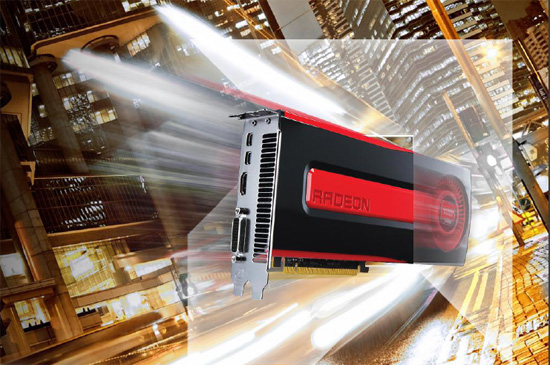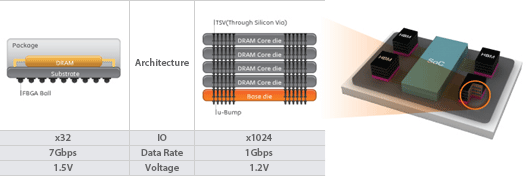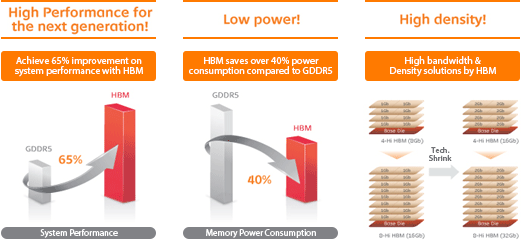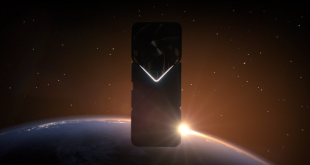Advanced Micro Devices’ next-generation graphics processing unit is still several months away, but it looks like it is worth waiting. According to unofficial information from SiSoft Sandra benchmark’s database, the forthcoming GPU features unprecedented compute horsepower as well as uses multi-layer high-bandwidth memory with extreme bandwidth.
If the listing in Sandra’s database is correct and really describes a prototype of the Radeon R9 390X “Fiji XT” graphics card, the next-generation offering from AMD will feature 4096 stream processors (SPs) (which, in case of the GCN 1.2 architecture, means 64 compute units and 256 texture units) and 4096-bit memory bus. The memory sub-system will rely on SK Hynix’s stacked high bandwidth memory (HBM) chips with 1024-bit input/output interface (compliant with the JESD235 standard [and, possibly, with the Wide IO protocol]).
The graphics card allegedly sports only 4GB of memory since the first-generation HBM features 2Gb DRAM dies and comes in 1GB memory devices, reports Wccftech. Only the second-generation HBM is expected to use 8Gb dies and therefore support 4GB and 8GB configurations.
If AMD’s Radeon R9 390X actually uses four first-generation HBM DRAM chips with 4096-bit memory bus operating at 1.25GHz, then the actual memory bandwidth the graphics card will sport will be whopping 640GB/s.
With 4096 stream processors and amount of bandwidth never before seen on a single-chip graphics cards, the Radeon R9 390X will be the fastest graphics adapter on the market. In fact, with such extreme amount of stream processors, it will clearly leave behind any graphics solution based on Nvidia Corp.’s GM200 graphics processing unit.
While performance-wise the Radeon R9 390X “Fiji XT” seems to be very powerful, it remains to be seen how expensive will it be. New types of memory tend to cost a lot. Moreover, given that memory devices have to be placed on the same piece of substrate with the GPU, the whole graphics card has to be redesigned.
AMD did not comment on the news-story.
Discuss on our Facebook page, HERE.
KitGuru Says: While in general listing in various benchmarks’ databases tend to be rather accurate, it is necessary to take them with a grain of salt. Moreover, keep in mind that for the second time in one week we get juicy details about next-generation graphics processing units from SiSoft Sandra’s database, which seems a bit suspicious.
 KitGuru KitGuru.net – Tech News | Hardware News | Hardware Reviews | IOS | Mobile | Gaming | Graphics Cards
KitGuru KitGuru.net – Tech News | Hardware News | Hardware Reviews | IOS | Mobile | Gaming | Graphics Cards






My poor wallet :<
This card is by AMD. I think if it was by NVIDIA then your poor wallet statement would have been very true.
WOW! and if it will be cheaper than Titan 2 then AMD rules!
Would still be pretty pricey for me though
as we have seen with the 970 😉 seriously, if you need a new GPU like me just be patient, it’s going to be a great year! The ones who get most out of the “war” between red and green are the gamers
Just wait for amds flagship and nvidias 980 ti or titan. 990?
This isn’t the first time AMD was rumored to be using a new type of memory (remember XDR?) I think its wise to wait and see.
Boy-o-boy…. When that HD7770 hits the shelves, I will be all over it.
Lol…
Patience.
lolamd
R9 395×2 or something.
too overpowered man.
Actually, its is not speculation at all in fact Nvidia is slated to begin using HBM a little later than AMD. The reason for Nvidia’s lag in using the memory is that AMD help pioneer it with SK Hynix.
i hope r9 395×2 will be a thing and it can crossfire with my r9 290x sapphire
There’s a difference between speculation and an actually working prototype.
That’ll definitely not happen as it’d be based on a completely different GPU core than your 290x.
Did you read the article? there isn’t anything confirmed nor is there a confirmed sighting of a working prototype.
I realize AMD has been investing in HBM but that doesn’t mean that they will be for sure using it in the 300 series, pricing is very important. We don’t know if they can get the price down to where they need it to launch next-year.
http://wccftech.com/amds-generation-fiji-xt-gpu-spotted-shipping-manifesto-radeon-r9-300-series-production-ramping/
This article is just a copy of another article. You also cannot have SiSoft benchmarks without having an actual working prototype, nor can you be shipping without a working product.
wccftech isn’t exactly the most reliable source…
Funny how I can deduce your mentality from that comment alone. Wccftech is irrelevant to my comment, which merely lists recursive sources such as:
http://videocardz.com/54013/amd-fiji-xt-spotted-at-zauba
Which came from:
https://www.zauba.com/import-fiji-xt-hs-code.html
But I’m sorry, you’re too intellectually challenged to argue against the content of my comment and instead just want to post a snarky reply.
Yeah, because Nvidia has never been known to charge ridiculous prices for their top-tier cards on release.
the article doesn’t say it uses a different architecture plus i heard amd gpus can crossfire with different gpus
“Fiji XT” is the architecture that the 390 is going to be using. Your 290X uses “Hawaii XT”, that’s a different architecture. Their GPUs can CrossFire with different variations of the same architecture (you could put an R9 290 (Hawaii PRO) in your system and they would run together just fine) but that’s it.
It can crossfire with different cards, but your 395 or whatever GPU you pick up will tend match the lower card. It would probably be an overall decrease in performance from just a standalone card. If nothing else, it’ll be an increase in your electric bill for negligible difference.
That better be the case cause if r9 390x is based on tonga architecture than AMD is seriously in deep trouble due to nvidia maxwell great performance at lower level power usage. Losing its gpu business will be gameover for the company.
Are you a moron? Obviously they’re not going to use an architecture for mid-range cards in their flagship. Fiji is going to share a lot of characteristics of Tonga that lowered power consumption, but have a much larger die, HBM, and a 20nm fab process.
i spent 4000 this year on cocaine alone.. lol 😀
Radeon R9 390X is not “Figi XT”. you are combining the 390X with 380X.
390X should be “Bermuda XTX” with 4224 Stream processors and 66 Compute Cores, 96 ROPs and 264 TMUs with 512 bit 1750MHz 8GB HBM memory and 1000 MHz core clock.
Well, looks like you’ve got absolutely no idea what you’re talking about.